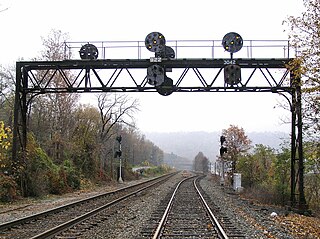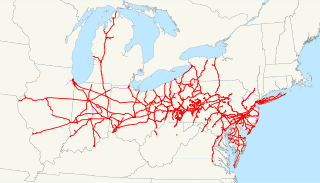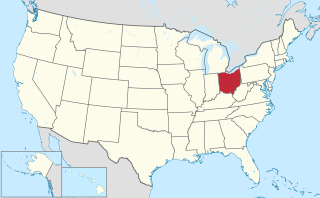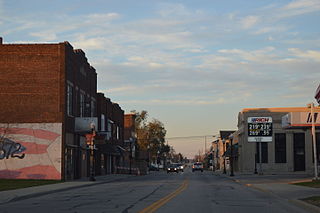
The Junction Railroad was a railroad created in 1860 to connect lines west of downtown Philadelphia, Pennsylvania, and allow north-south traffic through the metropolitan area for the first time. The railroad consisted of 3.56 miles of double track and 5.3 miles of sidings. It owned no locomotives or rolling stock. The line connected the Philadelphia and Reading Rail Road line at the west end of the Columbia Bridge over the Schuylkill River, crossed the Pennsylvania Railroad line, ran parallel to Market Street, and turned south to connect with the Philadelphia, Wilmington and Baltimore Railroad at Gray's Ferry.
The Pittsburgh, Fort Wayne and Chicago Railway was a major part of the Pennsylvania Railroad system, extending the PRR west from Pittsburgh, Pennsylvania, via Fort Wayne, Indiana, to Chicago, Illinois. It included the current Norfolk Southern-owned Fort Wayne Line east of Crestline, Ohio, to Pittsburgh, and the Fort Wayne Secondary, owned by CSX, from Crestline west to Tolleston in Gary, Indiana. CSX leased its entire portion in 2004 to the Chicago, Fort Wayne and Eastern Railroad (CFE). The remaining portion of the line from Tolleston into Chicago is now part of the Norfolk Southern's Chicago District, with a small portion of the original PFW&C trackage abandoned in favor of the parallel lines of former competitors which are now part of the modern NS system.
The Cincinnati and Richmond Railroad was part of the Pittsburgh, Cincinnati, Chicago and St. Louis Railway system.

The Pennsylvania Company, later known publicly as the Pennsylvania Lines was a major holding company. It included the Pittsburgh, Fort Wayne and Chicago Railway, the PRR's main route to Chicago. It also owned but did not operate the Pittsburgh, Cincinnati, Chicago and St. Louis Railroad, another line to Chicago. It merged back into the Pennsylvania Railroad in 1918.
The Keystone Subdivision is a railroad line owned and operated by CSX Transportation in the U.S. states of Maryland and Pennsylvania. The line runs from Cumberland, Maryland west to McKeesport, Pennsylvania along a former Baltimore and Ohio Railroad (B&O) line. The line includes the well-known Sand Patch Grade over the Allegheny Mountains.

The Harrisburg Subdivision is a railroad line owned by CSX Transportation in the U.S. state of Pennsylvania. The line is located in the city of Philadelphia, connecting Greenwich Yard and the Philadelphia Subdivision with the Trenton Subdivision along a former Pennsylvania Railroad line. Much of the Harrisburg Subdivision is the High Line or West Philadelphia Elevated along 31st Street over the 30th Street Station area.

The Buffalo Line is a railroad line owned by the Norfolk Southern Railway in the U.S. states of New York and Pennsylvania. The line runs from Buffalo, New York southeast to Rockville, Pennsylvania near Harrisburg, Pennsylvania along a former Pennsylvania Railroad line. Its north end is at Seneca Yard in Buffalo, with no direct access to the Lake Erie district, and its south end is at the Pittsburgh Line at Rockville. The line is operated by the Buffalo and Pittsburgh Railroad between Buffalo and Machias, New York, the Western New York and Pennsylvania Railroad between Machias and Driftwood, Pennsylvania, and the Norfolk Southern Railway between Driftwood and Rockville.
The Sandusky District is a railroad line owned and operated by the Norfolk Southern Railway in the U.S. state of Ohio. The line runs from Columbus north to Sandusky along a former Pennsylvania Railroad line. At its south end, it junctions or comes close to the Columbus District, Dayton District, and West Virginia Secondary. On the way to the Chicago Line at Sandusky, it meets the Chicago Fort Wayne and Eastern Railroad at Bucyrus and the Fostoria District and Cleveland District at Bellevue.
The Dayton District is a railroad line owned and operated by the Norfolk Southern Railway in the U.S. state of Ohio. The line runs from Columbus southwest to Cincinnati along former Pennsylvania Railroad and New York Central Railroad lines. Its east end is at or near the Columbus District, Sandusky District, and West Virginia Secondary; its south end is near Bond Hill, where it meets CSX Transportation's Cincinnati Terminal Subdivision and the Indiana and Ohio Railway's Midland Subdivision. Along the way, it junctions the New Castle District at Evendale.
The Conemaugh Line is a rail line owned and operated by the Norfolk Southern Railway in the U.S. state of Pennsylvania. The line runs from Conpit Junction northwest and southwest to Pittsburgh, following the Conemaugh, Kiskiminetas, and Allegheny rivers, on the former main line of the Conemaugh Branch of the Pennsylvania Railroad (PRR). At its east end, it merges with the Pittsburgh Line; its west end is where it merges with the Fort Wayne Line at the northwestern tip of Allegheny Commons Park. The line was used by the PRR as a low-grade alternate to its main line in the Pittsburgh area.

The Main Line of the Pennsylvania Railroad was a rail line in the Commonwealth of Pennsylvania, connecting Philadelphia with Pittsburgh via Harrisburg. The rail line was split into two rail lines and now all of its right of way is now a cross-state corridor, composed of Amtrak's Philadelphia to Harrisburg Main Line and the Norfolk Southern Railway's Pittsburgh Line.
The New Castle Branch was a rail line owned and operated by the Pennsylvania Railroad in the U.S. state of Pennsylvania. The line ran from New Castle north to Stoneboro, and is now entirely abandoned. At its south end, the line intersected the Erie and Pittsburgh Branch and Mahoningtown Branch. When the New Castle Branch ended at Stoneboro, the PRR had trackage rights east along the New York Central Railroad's Stoneboro Branch to Oil City and the Allegheny Branch, Chautauqua Branch, and Salamanca Branch.

The Butler Branch is a historic railroad line that operated in Indiana, USA. It ran between the city of Logansport on the Wabash River in north central Indiana and the namesake town of Butler near the Ohio border in northeastern Indiana.
The Fort Wayne Line and Fort Wayne Secondary is a rail line owned and operated by the Norfolk Southern Railway (NS), Chicago, Fort Wayne and Eastern Railroad (CFE), and CSX Transportation in the U.S. states of Pennsylvania, Ohio, and Indiana. The line runs from Pittsburgh, Pennsylvania west via Fort Wayne, Indiana to Gary, Indiana along what was once the Pennsylvania Railroad's Pittsburgh to Chicago Main Line.
The Columbus to Chicago Main Line was a rail line owned and operated by the Pennsylvania Railroad in the U.S. states of Ohio, Indiana, and Illinois. The line ran from Columbus, Ohio northwest via Logansport, Indiana to Chicago, Illinois. Junctions included the Columbus to Indianapolis Main Line via Bradford, which split at Bradford to reach the Pittsburgh to St. Louis Main Line at New Paris, Ohio; the Fort Wayne Branch at Ridgeville, Indiana; the Richmond Branch at Anoka, Indiana; and the South Bend Branch and I&F Branch at Logansport.
The Pittsburgh to St. Louis Main Line was a rail line owned and operated by the Pennsylvania Railroad in the U.S. states of Pennsylvania, Ohio, Indiana, and Illinois. The line ran from Pittsburgh, Pennsylvania west via Steubenville, Ohio, Columbus, Ohio, Dayton, Ohio, Indianapolis, Indiana, Terre Haute, Indiana, and Vandalia, Illinois to East St. Louis, Illinois. In addition to its east end in downtown Pittsburgh, where it met the Main Line and Pittsburgh to Chicago Main Line, junctions included the Columbus to Chicago Main Line at Columbus, the C&X Branch at Xenia, the Columbus to Indianapolis Main Line via Bradford at New Paris, the Richmond Branch and Fort Wayne Branch at Richmond, the Louisville Branch and I&F Branch at Indianapolis, and the Peoria Branch at Farrington, Illinois.
The Delaware Extension was a rail line owned and operated by the Pennsylvania Railroad in the U.S. state of Pennsylvania.
The Pennsylvania, Ohio and Detroit Railroad was a railroad company in the U.S. states of Ohio and Michigan that existed from 1926 to 1956. Its sole purpose was to simplify the corporate structure of the Pennsylvania Railroad by merging subsidiaries into a common company leased to the PRR; the PO&D was merged into the Connecting Railway in 1956.
The Vandalia Railroad Company was incorporated January 1, 1905, by a merger of several lines in Indiana and Illinois that formed a 471-mile railroad consisting of lines mostly west of Indianapolis.













